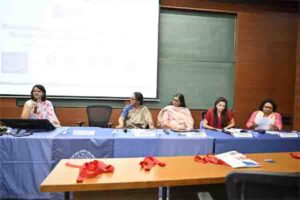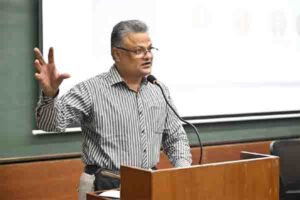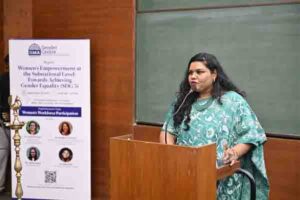- The report underscores the need for men’s participation in sharing household responsibilities to achieve work-life balance for both genders
- Of the sample of 705 districts, 67.5% of districts report women empowered in decision-making and mobility
- Only 46.1% districts reported educational empowerment
- The report, prepared and released by the Gender Centre at IIMA, provides valuable insights into the progress and challenges faced by women at subnational (district) level across India towards achieving the Sustainable Development Goal 5 on gender equality
NE EDUCATION BUREAU
AHMEDABAD, SEPT 21
Before the passage of Women’s Reservation Act, 2023, the 17th Lok Sabha had 14.4 percent or 78 woman MPs, says an IIM Ahmedabad report on the status of women in India. Despite a greater push for women’s participation in electoral politics, of the total elected members in the 18th Lok Sabha, 13.6 per cent or 74 MPs were women. This falls considerably short of the 33 per cent quota that will be designated for women under the Women’s Reservation Act, 2023.

The Gender Centre at the Indian Institute of Management Ahmedabad (IIMA) launched a report today on the status of women’s empowerment in India as per the parameters stipulated in the Sustainable Development Goal 5 (SDG 5) on gender equality, focusing on subnational (district) level variations. The report was released by Professor Satish Deodhar, Dean (Faculty), and Professor Vidya Vemireddy, Chairperson Gender Centre and co-author of the report.

The report, titled “Women’s Empowerment at the Subnational Level: Towards Achieving Gender Equality (SDG 5)”, introduces the Women Empowerment Index that provides a detailed, district-level analysis of women’s empowerment across India, offering new insights and data to help advance gender equality. The report is prepared with a comprehensive database sourced from several reliable platforms and Women Empowerment Index developed by the centre, which serves as a localised tool that is designed to measure empowerment at the district level in the following four key areas essential to achieving SDG 5 by the United Nations: 1) Decision-making, autonomy over income, and physical mobility, 2) Control over income and economic empowerment, 3) Educational and informational empowerment, and 4) Work-life balance. These domains capture the multifaceted nature of women’s empowerment, from their ability to make decisions and control financial resources to balancing paid and unpaid work.
By focusing on district-level data, rather than taking a broader state-wide approach, the report reveals the unique challenges women encounter in different regions and across different communities – from limited access to education and economic independence to the struggle for a better work-life balance – to enable more targeted interventions by districts. The study compared and analysed data for women aged between 15 to 49 from a total of 705 districts across the country from the National Family Health Survey-4 (NFHS-4) and NFHS-5, and it reveals a complex landscape with significant variations in women’s empowerment.
Some key findings from the report are:
- Of the sample of 705 districts, 67.5% of districts report women empowered in decision-making and mobility. There has been an increase in women’s involvement in decision-making, particularly regarding their own healthcare, household purchases, and how to spend their husband’s income. The percentage of women who make decisions either alone or jointly with their partners has grown.
- The percentage of women who have ownership of their own asset (land or house) alone or jointly with their partner has also increased from 29.09% in NFHS-4 to 35.00% in NFHS-5.
- Although women’s literacy rates have increased, only 46.1% districts reported educational empowerment, and women respondent in just 32.25% of districts felt that they were able to achieve work-life balance, highlighting ongoing challenges with unpaid domestic work.
- Higher education:The average number of women completing higher education increased from 11.43 per 100 women in NFHS 4 to 14.42 per 100 women in NFHS 5. But primary and secondary education didn’t show very significant difference.
- Furthermore, interest in mass media has also surged from 69.12% in NFHS-4 to 76.24% in NFHS-5, with more women engaging with various forms of media, indicating greater exposure to mass media (listening to radio, watching television, and reading newspapers).
Speaking during the report launch, Professor Satish Deodhar, Dean (Faculty), IIMA, underscored the need for men’s participation in sharing household responsibilities to achieve work-life balance for both genders. He said, “Of the four parameters studied in the report, the work-life balance parameter shows the least progress. Only about 32% of women reported that they could manage work-life balance. In my opinion, women’s workforce participation is intricately linked to responsible household work participation by men. As men have not taken their equal share of household responsibilities proactively, it is ultimately hindering the quality of labour-force participation of women. This report by the Gender Centre at IIMA serves not only as a measure of progress but also as a roadmap for future interventions to enhance women’s empowerment and participation in the workforce.”
Professor Vidya Vemireddy, Chairperson Gender Centre and co-author of the report, emphasised the importance of this initiative and said, “Our initiative at the Gender Centre at IIMA is to provide a replicable methodology which would help multiple stakeholders to generate localised district-level insights to identify and track progress and future areas of improvement in women’s empowerment and SDG 5 indicators. This effort is aimed to support existing policy and research ecosystem via ensuring a data-driven approach to monitor gender equality at local levels and towards achieving the SDG 5 (Gender Equality) goal.”

The report launch was followed by a panel discussion on the topic ‘Women’s Workforce Participation’. The panelists included: Meha Patel, Vice Chairperson, Zydus Foundation; Dr. Ranjitha Puskur, Principal Scientist, Gender & Livelihoods, International Rice Research Institute; Amrita Kumar, Director, Dayal Group; and Rumjhum Chatterjee, Chairperson, CII Centre for Women Leadership and Co-Founder and Managing Trustee of the Infravision Foundation.
On Thursday, the centre also held a stakeholder dialogue on “Realising Women’s Potential in Agri-food Systems”, which aimed to build an understanding of the challenges faced by rural women in agri-food systems across different regions of India and explore innovative and transformative solutions and good practices that can empower rural women.












